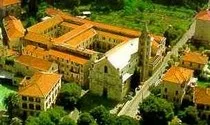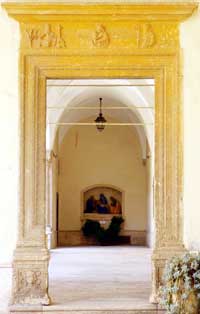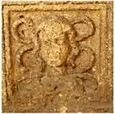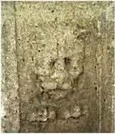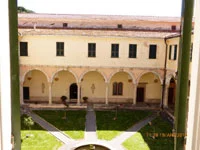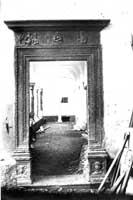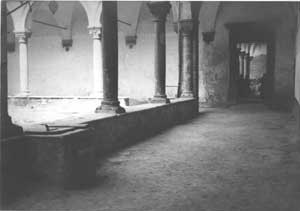portale segue
In the western part of the long wing of the monastery arose the monumental entrance portal, dated 1522, in pure Renaissance style.
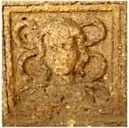
At that time the mythological characters of classical culture (Greek / Roman) preserved their charm and we find many evidences in architecture. The presence of a FURY (mouth wide open by a scream and the snakes of the hair), which is in the lower left box of our portal,it instilled respect and fear in those who approach to enter the area reserved for monks (called the cloister) of our monastery.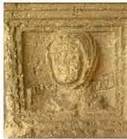

That you are entering the reserved area is indicated by the box to the right of the portal with the figure of the monk with the cartouche (the writing) SILENTIU (M).
IN 1500 THERE WERE NOT THE 2 CLOISTERS WE SEE TODAY
Now we wish to speak, in a particular way, of our ...
FIRST CLOISTER
of the first cloister is made up of the rooms located on the ground floor of the dormitory building: former cistern, chapter house, conference room.
But the arches of the cloister were built in a later period, as they do not correspond to the rooms behind them.
The south wing is the one adjacent to the church building, but the last pillar of the arches of its portico (the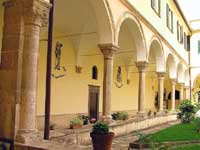 one near the driveway entrance) bears the date of its construction engraved: 1563. It is about thirty years old. after the long wing (completed in 1534). Here you can see on the cloister wall two works in wrought iron (S. Benedetto and the Madonna di Pia) removed for repainting. These two works, forged by our brilliant monk Fra Benedetto Sartoretti and approved by the Superintendency of Fine Arts, have yet to be relocated. It was easier to get rid of them than to restore them now, but with a little good will we can remedy what happened surreptitiously.
one near the driveway entrance) bears the date of its construction engraved: 1563. It is about thirty years old. after the long wing (completed in 1534). Here you can see on the cloister wall two works in wrought iron (S. Benedetto and the Madonna di Pia) removed for repainting. These two works, forged by our brilliant monk Fra Benedetto Sartoretti and approved by the Superintendency of Fine Arts, have yet to be relocated. It was easier to get rid of them than to restore them now, but with a little good will we can remedy what happened surreptitiously.
 one near the driveway entrance) bears the date of its construction engraved: 1563. It is about thirty years old. after the long wing (completed in 1534). Here you can see on the cloister wall two works in wrought iron (S. Benedetto and the Madonna di Pia) removed for repainting. These two works, forged by our brilliant monk Fra Benedetto Sartoretti and approved by the Superintendency of Fine Arts, have yet to be relocated. It was easier to get rid of them than to restore them now, but with a little good will we can remedy what happened surreptitiously.
one near the driveway entrance) bears the date of its construction engraved: 1563. It is about thirty years old. after the long wing (completed in 1534). Here you can see on the cloister wall two works in wrought iron (S. Benedetto and the Madonna di Pia) removed for repainting. These two works, forged by our brilliant monk Fra Benedetto Sartoretti and approved by the Superintendency of Fine Arts, have yet to be relocated. It was easier to get rid of them than to restore them now, but with a little good will we can remedy what happened surreptitiously.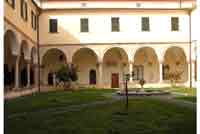 The west wing (the one with the tombstone of Pius VII, who returned from Napoleonic captivity, also passed through Finalpia) was built during the First World War. The building was raised by relying on previous buildings, hastily built by private individuals after the Siccardi laws, of 7 July 1866, relating to the expropriation of ecclesiastical assets.
The west wing (the one with the tombstone of Pius VII, who returned from Napoleonic captivity, also passed through Finalpia) was built during the First World War. The building was raised by relying on previous buildings, hastily built by private individuals after the Siccardi laws, of 7 July 1866, relating to the expropriation of ecclesiastical assets.The north wing (the one with the evocative scenes of monastic life, also the work of our industrious Fra 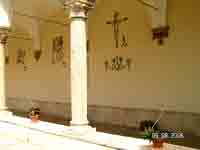 Benedetto Sartoretti) who forged them inspired by the masterful prints of a publication provided to him by our illustrious Fr Gregorio Penco.
Benedetto Sartoretti) who forged them inspired by the masterful prints of a publication provided to him by our illustrious Fr Gregorio Penco.
 Benedetto Sartoretti) who forged them inspired by the masterful prints of a publication provided to him by our illustrious Fr Gregorio Penco.
Benedetto Sartoretti) who forged them inspired by the masterful prints of a publication provided to him by our illustrious Fr Gregorio Penco.Almost in the east corner of this wing rises the solemn Renaissance portal, which delimits the area reserved for the cloister, that is, the area of silence reserved for monks.
Some activities that take place within the Abbey disturb the seriousness of the cloister, but it is to be hoped that they will not last forever.
Here is a photo of the famous Renaissance portal taken in 1921.
It should be noted that the floor of the arcades was still in beaten earth, just as it must have been at the beginning of the life of the monastery, in 1500.
Why was this solemn portal built?
For a ... WELL ...
For the excessive comings and goings of people who came there to draw water,
renowned for its extraordinary high quality!
RENOWED ANCIENT WELL
The torrent (the Sciusa) that flows a little further, in front of the facade of the Abbey church, to flow into the sea shortly after, flowed along the hill a long time ago: the one we see gradually rising towards the Manie plateau.
All streams and rivers, by virtue of the earth's rotation, tend to move their riverbed towards the east, and the Sciusa also followed the general trend.
However, for several centuries man has learned to move the bed of water courses, thus varying the path of the water flow.
In water and hydraulic problems, the Etruscans were already masters and the Romans succeeded as brilliant pupils.
Let's also leave Romulus and Remus bickering tragically in tracing the furrow of the perimeter of Rome, but let's not forget that some of the famous first 7 kings of Rome were really Etruscans (even if a little too pedantic or proud, if you prefer).
And so it happened that at the foot of this hill, right where the Sciusa flowed in ancient times, our monastery was built.
Man is capable of varying the bed of a watercourse, this operation succeeds well on the surface, but - easy easy- in the bowels of the earth, the water does not forget its old path, rather it seeks to follow it, as if nothing had happened (continue).
